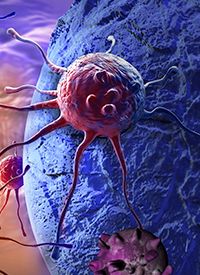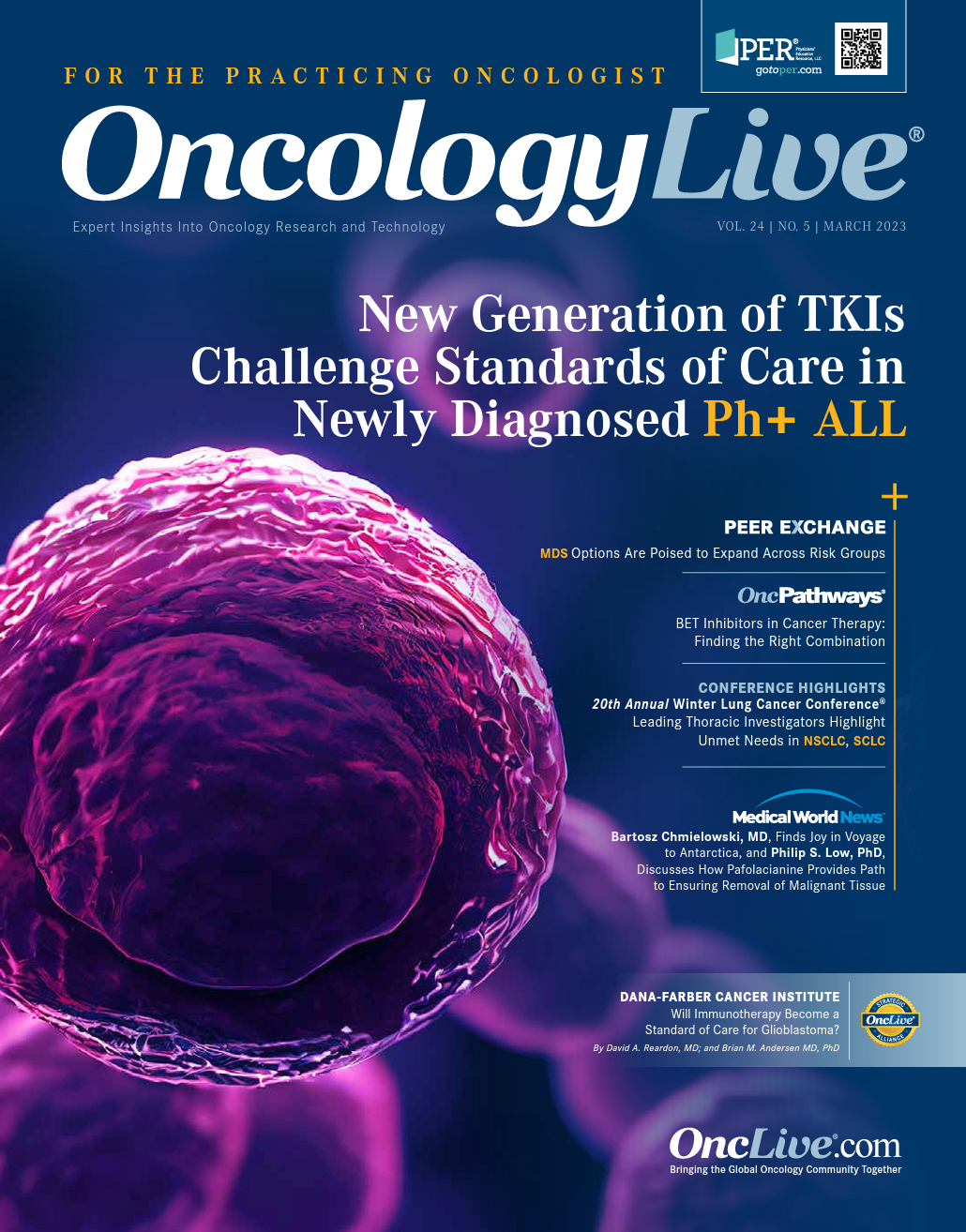Publication
Article
BET Inhibitors in Cancer Therapy: Finding the Right Combination
Author(s):
An understanding of BET protein dysregulation, which leads to abnormal expression of oncogenes, has prompted investigators to explore the idea of these proteins as a therapeutic target for cancer.
BET Inhibitors in Cancer Therapy:
© vitanovski - stock.adobe.com

Most members of the BET protein family are ubiquitously expressed in human tissues and play an important role in epigenetic regulation of gene transcription and cell-cycle progression.1 BET proteins are commonly dysregulated in human malignancies, which leads to abnormal expression of oncogenes. An understanding of these processes has prompted investigators to explore the idea of these proteins as a therapeutic target for cancer.1
Monotherapy with first-generation BET inhibitors was largely unsuccessful in clinical contexts because of dose-limiting toxicities (DLTs), particularly thrombocytopenia, that prevented escalation to a dose that would completely inhibit the target.1 However, development of rational therapeutic combinations that include BET inhibitors may deliver a synergistic antitumor effect and enable safe and effective use in the clinical setting.1 Investigators are testing a new crop of novel BET inhibitors as monotherapy and in combinations, particularly in hematologic malignancies (Table).
Table. Select BET Inhibitors in Clinical Development

Role of BET Pathway Proteins in Healthy and Malignant Cells
In a variety of contexts, the proteins BRD2, BRD3, and BRD4 are upregulated or abnormally expressed in activated immune cells, where they tend to exert proinflammatory effects.2 Another member of the BET family, BRDT, is primarily found in germ cells.3
Of the BET proteins, BRD4 has particularly abundant levels. Numerous stimuli cause elevated BRD4 expression in various resident immune cells, leading to increased transcriptional activation of immune and inflammatory genes.2 BRD4 may act as a stress protein. For example, it is upregulated in the uterus and fetal membranes during labor and infection, as well as in the placenta during severe early-onset preeclampsia.2
BRD2 expression is high in pancreatic ß cells, where it has been shown to interfere with mitosis and insulin transcription; induction of BRΔ2 expression also triggers the neuroinflammation associated with Parkinson disease.2
BRD3 expression is upregulated in activated lymphocytes, suggesting its involvement in the development of adaptive immunity, and has been found in macrophages in synovial tissue from individuals with rheumatoid arthritis and osteoarthritis.2
BRD2, BRD3, and BRD4 also have been shown to exert effects without changes in their expression. Further studies are needed to elucidate the mechanisms regulating the expression of BET proteins and the relationship between these proteins’ expression and function in various clinical settings.2
BET proteins also mediate changes in histone acetylation that can lead to development of cancer.3 BET proteins have been linked to abnormal expression of the MYC oncogene in mixed-lineage leukemia, acute myeloid leukemia (AML), Burkitt lymphoma, and Burkitt-like lymphoma.3
BET family proteins also can form oncogenic fusion proteins, such as the in-frame fusion of BRD and NUT, which is a key driver of NUT midline carcinoma.3
Interactions between BET proteins and nuclear factor κB (NF-κB), a proinflammatory, heterodimeric transcription factor, also contribute to cancer, and BRD2 and BRD4 are involved in constitutive activation of NF-κB in models of activated B-cell diffuse large B-cell lymphoma.1
BET Inhibition Strategies in Cancer
Because of the role of BET proteins in the development of many tumor types, inhibition of BET has been proposed as an antitumor strategy for the treatment of numerous solid tumors and hematologic malignancies.4
Additionally, BET inhibitors appear to target tumor cells over normal cells selectively because they bind preferentially to superenhancers, or noncoding DNA regions bound by multiple transcription factors that help determine cellular identity.4 Several BET inhibitors have been studied as monotherapy in early-stage clinical trials, although multiple DLTs, including thrombocytopenia, gastrointestinal and testicular toxicities, neutropenia, anemia, dysgeusia, and fatigue, precluded escalation to a dose that would be sufficient for adequate target inhibition.1 Therefore, strategies combining agents that act synergistically with BET inhibitors may be more successful as anticancer therapies and have shown promise in early-stage clinical trials.1
Pelabresib Plus Ruxolitinib
Pelabresib (CPI-0610) is an investigational, orally administered, small molecule BET inhibitor that reduces expression of BET target genes and modulates NF-κB signaling.5,6 Analysis of preliminary data from the open-label, phase 1/2 MANIFEST study (NCT02158858) of patients with myelofibrosis found that pelabresib plus ruxolitinib (Jakafi), a JAK1/2 inhibitor, led to a 35% or greater reduction in spleen volume (SVR35) in 68% (57 of 84) and a 50% or greater reduction in total symptom score (TSS50) at week 24 in 56% (46 of 82) of patients with JAK inhibitor–naïve disease (arm 3).5 SVR35 was achieved by 20% (16 of 81) and TSS50 occurred in 37% (30 of 81) of patients with myelofibrosis who previously had a suboptimal response to ruxolitinib (arm 2).5 Thrombocytopenia was the most common hematologic treatment-emergent adverse event (TEAE) in arm 3 (any grade, 52%; grade ≥ 3, 12%) and arm 2 (any grade, 52%; grade ≥ 3, 33%).5 Anemia was reported in 42% (grade ≥ 3, 35%) and 27% (grade ≥ 3, 19%) of patients in arm 3 and arm 2, respectively.5
Although low-grade gastrointestinal TEAEs and respiratory infections occurred, they rarely required discontinuation of treatment.5 Based on the findings in arm 3, the global phase 3 MANIFEST-2 trial (NCT04603495) was developed and is randomly assigning patients with JAK inhibitor–naïve myelofibrosis to receive pelabresib plus ruxolitinib or ruxolitinib alone (N = 200 per arm).6 SVR35 response and TSS50 response at week 24 are the primary and key secondary end points, respectively.6
BMS-986158 Plus Ruxolitinib or Fedratinib
BMS-986158 is an orally administered, potent, and selective small molecule BET inhibitor that has a dose-proportional pharmacokinetic profile and modulates BET target gene expression in a dose-dependent manner.7 Concomitant inhibition of BET-mediated and JAK/STAT pathways has additional therapeutic benefits over BET-targeted inhibition alone in patients with myelofibrosis.7
The phase 1/2 CA011-023 study (NCT04817007) includes a dose-escalation phase of BMS-986158 plus ruxolitinib in patients with myelofibrosis and no prior exposure to ruxolitinib (part 1A) or BMS-986158 plus fedratinib (Inrebic) in patients with myelofibrosis previously treated with ruxolitinib (part 1B). The study also includes a dose-expansion phase at the recommended phase 2 dose of BMS-986158 plus ruxolitinib (part 2A), BMS-986158 in combination with ruxolitinib (part 2A), or BMS-986158 with or without fedratinib (part 2B).7
A report of initial safety and efficacy data from parts 1A (n = 11) and 1B (n = 12) presented at the 2022 American Society of Hematology (ASH) Annual Meeting showed that DLTs occurred in 2 patients in part 1A (both thrombocytopenia) and 3 patients in part 1B (diarrhea, thrombocytopenia, and elevated bilirubin).7 All patients in part 1A remained on treatment, whereas 2 patients in part 1B discontinued treatment because of TEAEs (thrombocytopenia and elevated bilirubin).7
In part 1A, 5 of 6 evaluable patients (83%) achieved SVR35 at 12 weeks (mean SV change, −50.3%; SD, 14.5), and all 6 patients (100%) achieved SVR35 at 24 weeks (mean SV change, −56.8%; SD, 9.7).7 In part 1B, none of the 6 evaluable patients achieved SVR35 at 12 weeks (mean SV change, −9.9%; SD, 11.4) and only 1 of the 3 remaining evaluable patients achieved SVR35 at 24 weeks (mean SV change, −32.7%; SD, 11.2).7
The authors concluded that BMS-986158 combined with ruxolitinib or fedratinib had a manageable safety profile, and that the combination of BMS-986158 plus ruxolitinib led to a considerable reduction in SV that continued to deepen between 12 and 24 weeks of treatment in ruxolitinib-naïve patients.7
ZEN-3694 Plus Enzalutamide
ZEN-3694 is an orally administered, second-generation pan-BET inhibitor that reduces expression of androgen receptor (AR) signaling genes, AR splice variants, MYC, glucocorticoid receptor, and other oncogenes and has shown synergistic activity with enzalutamide (Xtandi), an AR inhibitor, in models of castration-resistant prostate cancer (CRPC).8 A first-in-human, phase 1b/2 trial (NCT02711956) evaluated the safety and efficacy of ZEN-3694 plus enzalutamide in 75 patients with metastatic CRPC and prior progression on at least 1 androgen signaling inhibitor.8 Grade 3 or higher TEAEs were observed in 18.7% of patients, with nausea (4%), thrombocytopenia (4%), anemia (2.7%), fatigue (2.7%), and hypophosphatemia (2.7%) most commonly reported.8 The most common any-grade AEs attributed to ZEN-3694 were visual disturbances (67%), nausea (45%), fatigue (40%), decreased appetite (25%), dysgeusia (20%), thrombocytopenia (15%), and decrease in body weight (11%).8 Dose reductions or treatment discontinuation due to AEs were needed in 32% of patients, with gastrointestinal toxicities accounting for 83% of discontinuations and dose reductions.8
Pharmacodynamic analysis showed dose-dependent decreases in whole-blood mRNA levels of several BET inhibitor target genes, and the mean radiographic progression-free survival (rPFS) was 9.0 months (95% CI, 4.6-12.9).8 The on-treatment median rPFS was 10.6 months (95% CI, 7.5-not reached) among the subset of 12 patients with primary resistance to first-line AR-targeted therapy.8
These findings prompted the initiation of an open-label, randomized phase 2b trial (NCT04986423), which is comparing ZEN-3694 plus enzalutamide with enzalutamide alone in 2 cohorts of patients with metastatic CRPC who have progressed on abiraterone acetate (Zytiga), an antiandrogen therapy.9 Cohort A (n = 150) includes patients who had a poor response to abiraterone, and cohort B (n = 50) consists of patients who responded to abiraterone.9 The primary end point is rPFS by blinded independent central review in cohort A evaluated by Prostate Cancer Clinical Trials Working Group 3 consensus for trials in CRPC.9 The study, which seeks to enroll 200 participants, was launched in September 2021 and has an estimated primary completion date of March 2024.
ZEN-3694 Plus Talazoparib
ZEN-3694 also has been shown to decrease mRNA levels of multiple genes involved in DNA repair, thus increasing sensitization of PARP inhibitor–resistant breast cancers to PARP inhibitors.10 Although PARP inhibitors typically are administered only to patients with breast cancer with germline BRCA1/2 mutations, ZEN-3694 is believed to be effective in BRCA wild-type and BRCA-mutant tumors.10
A phase 1b/2 trial (NCT03901469) evaluated ZEN-3694 in combination with the PARP inhibitor talazoparib (Talzenna) in 52 patients with triple-negative breast cancer (TNBC) without germline BRCA mutations, and results were presented at the 2022 American Society of Clinical Oncology Annual Meeting.11
Thrombocytopenia was the most common AE (any grade, 55%; grade ≥ 3, 34%), although this was ameliorated with dose holds and reductions.11 Assessment of BET-dependent and homologous recombination repair transcripts in paired tumor biopsies taken before and after treatment revealed robust engagement of target DNA repair genes on treatment.11
In the phase 2 portion of the trial, the clinical benefit rate, defined as objective response rate (ORR) plus stable disease for more than 16 weeks, was 30% (11 of 37 patients), which met that phase’s primary end point.11 For the entire phase 1b/2 trial, the investigator-assessed ORR was 22% (11 of 50 patients, including 2 complete responses), the clinical benefit rate was 35% (18 of 51), and median duration of response was 24 weeks.11 Notably, all the confirmed responses occurred in the subset of 34 patients with TNBC at diagnosis (ie, no history of hormone receptor–positive disease), consistent with the expectation that TNBC tumors would be more sensitive to the combination because of their basal-like properties.11 The trial has been expanded to phase 2b, in which enrollment of an additional 80 patients with TNBC at diagnosis is planned.11
PLX51107 Plus Dinaciclib
PLX51107 is a BET inhibitor with a novel binding site in the acetylated lysine-binding pocket of BRD4, which exerts effects on gene transcription.12,13 PLX51107 showed antitumor effects in in vitro and in vivo models of AML; however, extended exposure to BET inhibition can lead to resistance mediated by increased activation of the canonical ß-catenin–dependent Wnt signaling pathway.12,13
PLX51107 may exert synergistic activity with dinaciclib, a multi-CDK inhibitor, and reverse resistance to BET inhibition by inhibiting Wnt signaling.13 Results of a preclinical study presented at the 2022 ASH Annual Meeting showed that PLX51107 and dinaciclib had synergistic activity in AML cell lines, as demonstrated by a decrease in mitochondrial activity.13 Additionally, dinaciclib downregulated Wnt/ß-catenin signaling in AML cell lines, and sensitivity to dinaciclib was similar in PLX51107-resistant and -sensitive cells.13
The combination of PLX51107 and dinaciclib also demonstrated synergy in a xenograft mouse model of AML. In addition to decreased disease burden, mice that received the combination had significantly longer median overall survival than those that received PLX51107 alone or vehicle treatment (57 days with combination vs 42 days with PLX51107 and 28 days with vehicle treatment; P < .05); dinaciclib alone did not improve survival compared with vehicle treatment.13 The authors concluded that these data support the addition of a multi-CDK inhibitor as a potential strategy for thwarting resistance to BET-targeted agents in AML.13
Future Directions
Inhibition of BET has emerged as a promising anticancer strategy in several tumor types, and development of rational therapeutic combinations may allow clinical benefits to be achieved from BET inhibitors at tolerable doses.1 Development of more selective BET inhibitors such as agents that selectively target the BD1 or BD2 domain on all 4 BET proteins or that target specific BRDs, targeted delivery approaches such as antibody-drug conjugates, or therapies that selectively degrade BRDs may be other strategies to maintain or improve efficacy of BET inhibitors while reducing hematologic toxicity.1
References
- Trojer P. Targeting BET bromodomains in cancer. Ann Rev Canc Biol. 2022;6:313-336. doi:10.1146/annurev-cancerbio-070120-103531
- Wang N, Wu R, Tang D, Kang R. The BET family in immunity and disease. Signal Transduct Target Ther. 2021;6(1):23. doi:10.1038/s41392-020-00384-4
- Alqahtani A, Choucair K, Ashraf M, et al. Bromodomain and extra-terminal motif inhibitors: a review of preclinical and clinical advances in cancer therapy. Future Sci OA. 2019;5(3):FSO372. doi:10.4155/fsoa-2018-0115
- Doroshow DB, Eder JP, LoRusso PM. BET inhibitors: a novel epigenetic approach. Ann Oncol. 2017;28(8):1776-1787. doi:10.1093/annonc/mdx157
- Mascarenhas J, Kremyanskaya M, Patriarca A, et al. BET inhibitor pelabresib (CPI-0610) combined with ruxolitinib in patients with myelofibrosis—JAK inhibitor-naïve or with suboptimal response to ruxolitinib—preliminary data from the MANIFEST study. HemaSphere. 2022;6:99-100. doi:10.1097/01.HS9.0000843684.97625.7e
- Harrison C, Rampal RK, Gupta V, et al. MANIFEST-2, A global, phase 3, randomized, double-blind, active-control study of pelabresib (CPI-0610) and ruxolitinib vs placebo and ruxolitinib in JAK inhibitor-naïve myelofibrosis patients. HemaSphere. 2022;6:920-921. doi:10.1097/01.HS9.0000846988.26018.ea
- Ayala R, Lopez N, Shacham Abulafia A, et al. BMS-986158, a potent BET inhibitor, as monotherapy and in combination with ruxolitinib or fedratinib in intermediate- or high-risk myelofibrosis: first results from a phase 1/2 study. Blood. 2022;140(suppl 1):9665-9667. doi:10.1182/blood-2022-159476
- Aggarwal RR, Schweizer MT, Nanus DM, et al. A phase Ib/IIastudy of the pan-BET inhibitor ZEN-3694 in combination with enzalutamide in patients with metastatic castration-resistant prostate cancer. Clin Cancer Res. 2020;26(20):5338-5347. doi:10.1158/1078-0432.CCR-20-1707
- Aggarwal RR, Schweizer MT, Nanus DM, et al. A randomized mCRPC phase 2b study of the BET bromodomain inhibitor (BETi) zen-3694 and enzalutamide versusenzalutamide. J Clin Oncol. 2022;40(suppl 6):TPS201. doi:10.1200/JCO.2022.40.6_suppl.TPS201
- Campeau E.Phase 1b/2 combination study of the BET inhibitor ZEN-3694 with the PARP inhibitor talazoparib for the treatment of TNBC patients without germline BRCA1/2 mutations. Presented at: Triple Negative Breast Cancer Drug Development Summit; April 28-29, 2021; Virtual. Accessed January 26, 2023. https://www.zenithepigenetics.com/upload/media_element/145/c2f0c3e6c3b4/eric-campeau--tnbc-summit-april-2021-presentation.pdf
- Aftimos PG, Oliveira M, Punie K, et al. A phase 1b/2 study of the BET inhibitor ZEN-3694 in combination with talazoparib for treatment of patients with TNBC without gBRCA1/2 mutations. J Clin Oncol. 2022;40(suppl 16):1023. doi:10.1200/JCO.2022.40.16_suppl.1023.
- Grieselhuber NR, Mitchell SR, Orwick S, et al. The novel BET inhibitor PLX51107 has in vitro and in vivo activity against acute myeloid leukemia. Blood. 2016;128(22):3941. doi:10.1182/blood.V128.22.3941.3941
- Marr A, Karmahapatra S, Corbin D, et al. The multi-CDK inhibitor dinaciclib shows synergistic activity with the BET inhibitor PLX51107 and reverses BET resistance through inhibition of canonicalWnt signaling in acute myeloid leukemia (AML). Blood. 2022;140(suppl 1):3075-3076. doi:10.1182/blood-2022-160277









